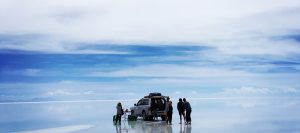1. Uyuni
Where else does one get the chance to walk on the sky? In the day, the earth’s largest salt desert glitters like crushed diamonds for miles in all directions, and at night, with a little rain, the ground becomes a mirror: the stars so clear you can almost bend down and pluck them.
Neil Armstrong is quoted as saying that Uyuni’s the closest thing the earth has to the moon. But actually Uyuni’s better than the moon, because it has flamingos, and a type of large, long-tailed South American rabbit, affectionately known as a “Pikachu” — (although, environmentally, it might not be a good idea to feed them, as many tourists like to do.)

Four-by-fours take you straight through the flats on either a one-, a three-, or a five-day tour, but the region is so vast and spectacular, at least three days is recommended.
Flamingos flock like pigeons to drink from sulfuric, red lagoons that look not of this world. Nearby thermal springs feel wonderfully restorative, especially at night, as this altitudinous desert begins to cool.
The tour guides, by now, are skilled at directing amusingly inventive photographs and they will all but force you to balance like ballerinas in the palms of each other’s hands.
The guides, experienced and professional, will take care of almost everything, but be sure to bring serious sun protection. Sunscreen, a wide-brim hat, and sunglasses are (or should be) mandatory. All tours provide meals, and, if you’re spending the night, accommodation in quaint hotels carved completely of salt. Bring snacks and extra water to be safe, but, overall, your tour takes care of everything.

2. La Paz
Probably the most astonishing public transportation the world has to offer are the cable cars of La Paz. Do not be fooled, as many first-time tourists often are, into taking a taxi from the airport. The cable cars are cheaper and they bear you down from the mountains gently into the world highest capital city.
Death Road is a must. The ride is thrilling, world-famous, and in place of streets signs it’s grave markers all the way down. But in truth the guides are professional and you never feel unsafe

Just walking around this city is a tour in itself, but you won’t want to miss the Witch’s Market. To list the things sold there would require a bigger internet, but among what’s for sale are petrified llama fetuses, automatic weapons, your future told with coca leaves, and handmade jewelry with spells of bad luck imbued into their gemstones.
The city is something to see, breathtaking but crowded, and after a while, you’ll crave somewhere peaceful. Lake Titicaca and its Isles of Sun and Moon feel like paradises built especially for those in need of break from a city’s speed. Let days become weeks by the glittering lakeside.

3. Sucre
Sucre is a cool, charming city with colonial-style architecture, beautiful cathedrals, and a world-famous cemetery.
Several historical tours are offered within the city, but if you’re wanting to explore, the Maragua tour is the thing. Its so-called “crater” is actually the result of a rare geological phenomenon, one that makes available bizarrely colored soils, dinosaur footprints, and crystalline swimming holes fed by mountain streams.
In the relaxing city of Sucre, the hostel, Villa Oropeza Guest House, is gaining a reputation as one of the best (and most affordable) rest stops in all of South America.
10 INCREDIBLE THINGS TO DO IN SUCRE BOLIVIA

4. Potosí
The biggest attraction of Potosí are its silver mines, which you can actually go down into and “tour.” This tour is, however, controversial, as the mines allow several problematic workplace practices, such as employing children at a low wage to do very dangerous work, and the money you pay for the tour goes, not to the families, as it should, but directly to the company that owns the mines.
But just outside the city is the Toro Toro National Park, home to brontosauri footprints and canyons so deep you’ll want to scream at the abyss.

5. Samaipata
Maybe the most tranquil little mountain town in all of South America, Samaipata’s hostels are inexpensive, its streets are cobbled, and its crisp mountain air makes you buy just one more baby alpaca’s wool blanket to nap in.
Near the town’s plaza it’s easy to find guides who’ll take you trekking in the green mountains. It’s not uncommon to see condors, who smell the food in your pack, drift in and hover, sometimes just meters above your copiously sun-screened forehead.
Known for hidden waterfalls and spirit-healing plants, Samaipata is an ideal destination for anyone looking to relax, rejuvenate, and reap the benefits of Andean mountain magic.

6. Sajama National Park
Bolivia’s oldest national park boasts its highest mountain, the snow-capped volcano that gives the park its name.
In Sajama, some of the highest forests in the world shelter some of our rarest animals, from Andean mountain cats to flamingos to spectacled bears.
And then, just as the altitude is getting to be too much, relax and submerge yourself into one of Sajama’s thermal springs.

7. Rurrenabaque
Welcome to the jungle, but not just any jungle. Rurrenabaque and the surrounding area boast what some biologists argue is the most diverse and varied ecosystem on earth. To even begin a list of species would take so much time that the entire Amazon rainforest would be one giant soybean farm before I was finished writing it. Even still, how could I resist mentioning the howler monkeys, the anacondas, the pink dolphins, and, of course, the caimans — giant South American gators who eyes glow under the river at night.
Canoe tours, jeep tours, intense machete-crazed survival tours deep into the pampas — these are just the beginning. If you have any interest in meeting that which some locals call “the jaguar mother” Rurrenabaque is the place. (This website is no way condones the licking of frogs’ backs, not without professional supervision.)
Practical advice: bring mosquito repellent and long sleeves — but not black. Locals claim that mosquitos are drawn to black clothing because it makes them think you’re an animal. (Also, for complex ecosystem reasons, please don’t feed the monkeys!)

8. Jesuit Missions in Santa Cruz
It is recommended that, before visiting the history-rich Jesuit Missions outside Santa Cruz, you watch the major motion picture The Mission which, although set in Paraguay, apparently sourced much of its research from number 8 on our list.
Regardless of your interest in religion, this place’s awestriking architecture is not to be missed. In general, the feeling of this place is one that even nonbelievers are likely to describe as holy, especially when the choirs begin to sing.

9. Tupiza
Known as the safest city in Bolivia, Tupiza is a great place to kick back in between stays in larger municipalities.
Besides a popular guided tour to the spot where Butch Cassidy and the Sundance Kid allegedly met their end, Tupiza is the place to go horseback riding.

10. Tarija
Bolivia isn’t known for its wine, but once you visit Tarija, you’ll think that it should be. Any hostel or tour guide will be able to point you toward a wine route. Rent a bike or walk. Or enjoy inexpensive, high-quality wine right here in the city’s old town, where its neoclassical architecture makes you wonder, as you sip your vino, if you’ve somehow arrived in the Mediterranean.




